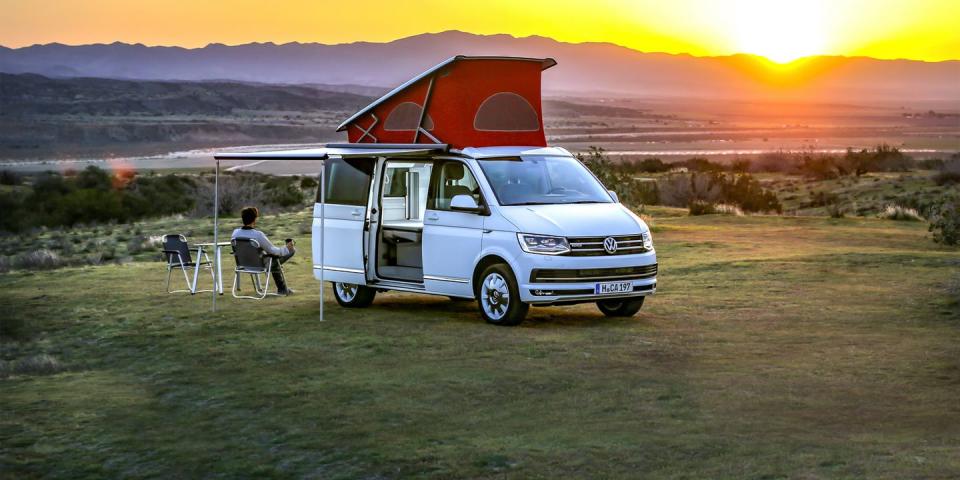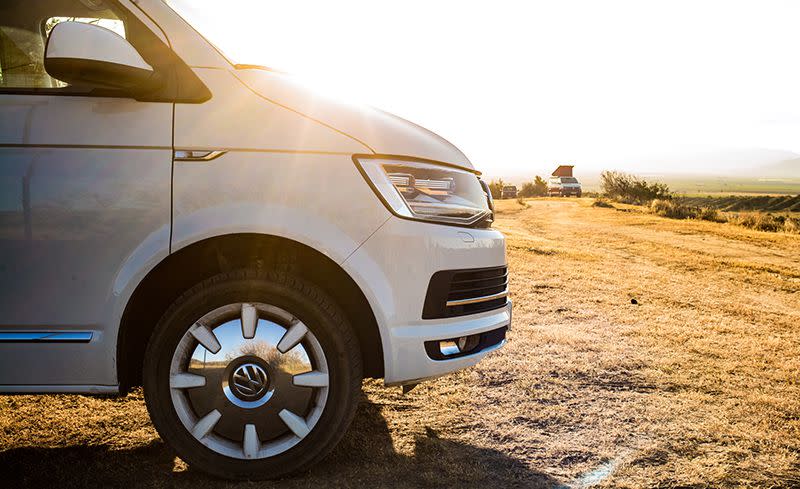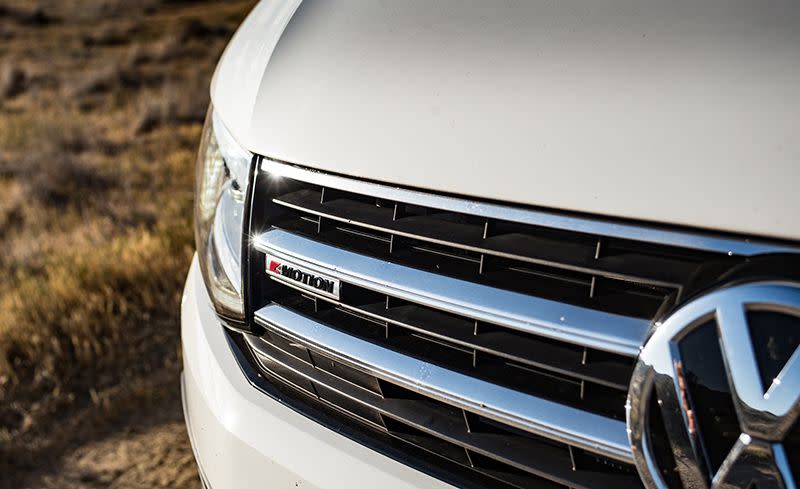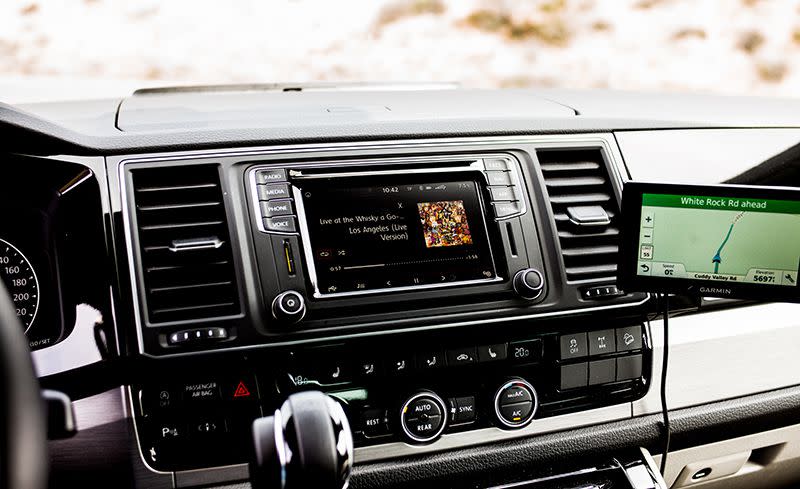California Über Alles! We Drive VW’s Fantastic Camper Van

As a native Californian, I often forget what all the fuss is about. We’ve got our petty rivalries here. The folks in the northern Sierras and Cascades dream of absconding with southern Oregon to create the State of Jefferson. Generalized NorCal types gripe about the superficial bogosity of our brothers across the Tehachapis. Coastal dwellers grumble about the inland hicks. Those of us on the river system grumble about Big Ag in the southern San Joaquin Valley and how its incessant demand for water decimates our fisheries. Meanwhile, the farmers complain about the greedy hippies in Sacramento who won’t let them grow food because of some stupid little fish. Stony shredders up in Tahoe just wanna send it. And everybody hates the moneyed, milquetoast techbros who managed to do what the FBI’s COINTELPRO couldn’t back in the 1960s-demolish a vibrant Bay Area countercultural tradition.
There’s enough day-to-day internecine squabbling and finger-pointing to make a person forget that to the rest of humanity, California is one of the world’s great, mythic places. It’s storied enough that no less than Ferrari has named three cars after it (four if you count the long- and short-wheelbase versions of the 250GT as different automobiles), Ford has a recurring California Special package for the Mustang, and Volkswagen has offered a California model for the past 30 years.

Goldbären Flag
If you’re unfamiliar with the Volkswagen California, that’s understandable, as the model has never been offered in the United States. You are, however, no doubt familiar with its progenitor, the Westfalia pop-top camper. Westfalia-Werke began modifying Volkswagen Microbuses for live-aboard duty early in the storied van’s career and kept at it until-and even after-Westfalia was bought out by DaimlerChrysler in 2001. In 2003, VW launched its in-house version of the California, based on the T5-generation Transporter. Although the current, T6-based California launched in 2015, Volkswagen Nutzfahrzeuge (literally, Vehicles of Use; officially, Commercial Vehicles) recently staged an event celebrating three decades of the van in California, aiming to give writers from around the globe a taste of the Southern California lifestyle. Since the campers were here, the Germans invited American journalists out for a crack at the sort of machine we haven’t seen since the T4 EuroVan went the way of the California grizzly bear after the 2003 model year. Having lived in the Golden State for 41 years, I was largely disinterested in a German tourist’s vision of my home state, so I skipped many of the planned stops in favor of my own beloved roads and spots; I also took a nap, ate strawberries, and listened to loud music.
We picked up our vans in a parking lot at Los Angeles International Airport, truly a wondrous and frustrating locale, its own little Angeleno microcosm. I cued up “Van” by the Descendents, who formed just down the coast from the airport and released their early albums on New Alliance and SST, South Bay record labels at the vanguard of the American underground in the 1980s. Creeping up the chockablock 405, Robert Downey Jr.’s custom 1970 Mustang passed me on the back of a transporter. So far, so good, so Los Angeles. Stopping in Malibu, I picked up some strawberries and a pair of socks featuring the Descendents’ Milo Goes to College album art. Synergy, man. It lives in these canyons. Finally breaking out of traffic, I rounded Point Mugu on Highway 1 and caught sight of a pair of C-130s sitting on the apron at the Air National Guard base.
Back in the 1970s, my old neighbor Jim used to fly Navy Hercs out of Mugu as part of Antarctic Development Squadron Six. Despite their base south of sunny Ventura, VXE-6 was tasked with flying their ski-equipped LC-130s from forward operating bases into Antarctica. Takeoffs from the frozen continent often employed JATO boosters. Rockets and skis? How is that anything less than entirely badass? When I was a kid, Jim flew civilian 130s for Flying Tigers and Southern Air Transport, and I’ve had a lifelong affection for the versatile transports because of his history with them. They were designed in Burbank, after all.
Size and Perspective
Just north of Point Mugu, I stopped at a Best Buy in Oxnard for a memory card and parked the California between a pair of Geek Squad Transits. Sitting between the Fords, the Transporter is obviously one size class down from the big vans. In markets where Volkswagen goes head to head with Ford in the work-van segment, the Transit’s competition is the VW Crafter. The T6 is roughly a Mercedes-Benz Metris–sized proposition, and although the Daimler product is longer, the Volkswagen looks larger.
North of Ventura, I pulled over above a beach where we spent a pleasant January afternoon shooting an Audi A3 cabriolet three years ago, pulled the strawberries out of the fridge, and played a little harmonica while I took in the afternoon salt air. When Matthias Hohner, a Swabian clockmaker, made his first harmonicas in 1857, he likely had no idea that they’d become one of the defining sounds of the American West. And I doubt that 90 years later, Dutch VW importer Ben Pon figured that the Beetle-based van he sketched for the boys in Wolfsburg would become a fixture on the American West Coast, as potent a shorthand for 1967 California as Jimi Hendrix’s flaming guitar at the Monterey International Pop Festival.
The T6 California has eight times the horsepower of the original Type 2, offering 201 ponies and 258 lb-ft of torque. That doesn’t seem like a whole lot, given that a Honda Odyssey offers 280 horsepower, but I never felt like the VW lacked for power, despite VW’s quoted 10.5-second zero-to-62-mph time for the front-wheel-drive version. The chassis is nothing short of excellent, supplying a plush, well-damped ride that nevertheless offers plenty of warning when one’s in danger of overcooking things in a corner. That is, if the bottles of fizzy water clanging around in the fridge aren’t warning enough. On the freeway, the van is happy to cruise at extralegal speeds, although it’s not exactly immune to crosswinds. On a winding mountain road, the Cali tends to be content right around the posted limit. Give it extra beans in the bends, and the weight of the pop-top roof makes itself known.
As the in-dash infotainment system wasn’t set up with North American maps, VW had supplied us with Garmin nav units. With some time to kill before I was due at the first night’s campsite, I ventured down State Route 150, a lovely ribbon of asphalt that ripples through the hills between Carpinteria and Ojai. When it was time to head to camp, the Garmin suggested I take 23 miles worth of fire roads to get from where I was to the campsite. Two miles in, a sign threatened me with all manner of death, dismemberment, and incarceration if I proceeded farther. There was also an impassable gate. Really, the gate alone would’ve been enough to deter me. Back on the paved road, it turned out that camp was only about eight miles away. Still, the all-wheel-drive van had handled the rutted dirt road with aplomb, and the view of Lake Casitas from the fire road was pretty outstanding.
Setting up the camper turned out to be a pleasurable scavenger hunt. A VW representative skittered about, pointing out the van’s hidden features, like the battery-operated footlight that detaches to become a handy flashlight and the folding chairs zippered into a compartment in the liftgate. Integrated into the van’s single sliding door is a pop-out freestanding table for outdoor use. A drawer under the rear seat has a crank handle clipped into it. Take it out, slip it into a hole at the rear end of the awning, and with a few winds of the handle, you’ve got outdoor shade.
The pop-up roof itself is easy as pie to put up. There’s a monochrome multifunction display in the ceiling console. Simply select the top, choose whether you’d like to open or close it, then push the button centered in the controller knob. The bed is mounted on gas struts, so it can be pushed up and out of the way to allow standing inside the van, handy when one’s on chef duty. The rear seat also easily unfolds into a bed, and although I extended it for the sake of science, I couldn’t bring myself to sleep in it. I am, after all, a six-year-old boy at heart, and six-year-old boys want to sleep upstairs in the tent.
Oil and Water, Cracks and Naps
Up in the loft, I unzipped the shade facing the Pacific Ocean, conked out to the distant sound of surf and the quiet whoosh of US 101 below me, and awoke to the sight of the oil platforms dotting the Dos Cuadras and Carpinteria fields between the Santa Barbara County shoreline and Santa Cruz Island. In 1969, when Unocal was first drilling out here, a blowout caused what’s now the third-worst oil spill in American history, after the Exxon Valdez and Deepwater Horizon. I remember scraping tar off my Boogie board in the 1980s, just up the coast at El Capitan, and my mother telling me about the spill. To my young mind, 1969 seemed so long ago, but it wasn’t, not really. It’d been only a decade and a half since Bryan Adams picked up his first real six string. It’s now been well over two decades since I picked up mine. But given that I’ve never seen the waters off Santa Barbara without them, the drilling rigs seem eternal. Thankfully, they’re not. Shell is dismantling the platforms in the North Sea’s famed Brent Field, and one day, the Dos Cuadras platforms will meet the same fate. The rigs seem an anomaly in an area of such natural beauty, a reminder of an era that lasted from the Gold Rush until into the 1970s, when California-having dammed every stream easily dammed, farmed every bit of land easily farmed, mined everything easily mined, and logged everything easily logged-realized that perhaps its resources weren’t infinite after all.
After spending a little too much time musing on the oil rigs, I wanted to see a bit of unspoiled California. Luckily, the next night’s campsite was in the Cuyama Valley, not far from the Carrizo Plain National Monument. So after a middling burrito in Ojai-after a decade’s worth of Mission District burritos in San Francisco, every other burrito is middling by comparison-I set off over Mount Pinos for California’s last unspoiled natural grassland. Naturalist John Muir once walked across our Central Valley. No mean feat, given that said valley is roughly the size of the northern half of Tennessee. Fly from L.A. to Sacramento today, and, if you look down, you’ll see some 300 miles worth of agricultural geometry bounded by the Coast Range on the left and the Sierras on the right. Green square, brown square, vaguely different green rectangle, Fresno to starboard, Coalinga and Avenal to port. Muir, however, describes walking across a vast plain filled with wildflowers, which I like to think of as the inverse of the valley’s modern big-money squares. Last year, after a very wet winter, the Carrizo Plain turned into a small-scale version of the place Muir experienced. Local media termed it the “superbloom.” I caught the tail end of it, bounding up the plain on a dirt bike, meeting car after car full of people who’d come out to see the flowers. The place is usually empty, just me and the odd rattlesnake. If you’re lucky, you might see some pronghorn antelope. I’ve never been that fortunate, but the emptiness and sparse wildlife of the plain is a reminder of just what a foreboding land we’ve ostensibly tamed.
I hadn’t fallen asleep until late the night before, and I was feeling it, so I pulled over next to a great crack in the earth. The San Andreas Fault runs right up the plain, and there’s visible evidence of seismic activity all over the place, though I suppose this miniature double ravine could’ve been cut by a stream of some sort. Whatever its cause, it’s always a touchstone of my trips up the plain, and today I figured I’d pop the roof, clamber on up, and sleep for an hour as the afternoon westerlies buffeted the van.
A couple of hours later, I found myself watching the sun set over the mountains from a plateau above the Cuyama Valley. With the darkness came a chill, and the VW’s gasoline-fueled heater kept the van perfectly toasty all night.
Of Dio and Deserts
The next morning, I cranked in the awning, dropped the top, stowed the table, and set off into the San Emigdio Mountains cranking Black Sabbath’s Heaven and Hell. There’s something about this corner of California that pairs naturally with the Ronnie James Dio–fronted incarnation of the band. It’s a patchwork of oil wells from Lost Hills down to Taft, Cuyama Valley agriculture, rolling ranchland, and pine forests that is somehow of a piece, all perfectly soundtracked by three blokes from Birmingham, England, and a mystical little dude from Cortland, New York. I’m not exactly sure why, but I think it has something to do with the fact that the mountains seem to go every which direction down here and don’t really sort themselves out for good until you hit Highway 46.
I made my way to Lebec, hopped on I-5, then struck east on State Route 138 out into the Mojave, blasting past Joshua trees and unremarkable chaparral, wind farms spinning to the north in the corner of my eye. State Route 14 took me back into the sprawl of Los Angeles, and I blared L.A.’s most perfect band, X, all the way back to Lawndale. I hadn’t been down the 405 in daylight since the winter’s fires. Hillsides that’d been totally denuded by flame were showing signs of life, once again green with ground cover. Only the inky, skeletal trees gave away what’d happened here just six months prior. In Los Angeles, even the landscape forgets.
The Volkswagen California I drove, a top-of-the-line Ocean Red model, would set one back about $110,000 if VW deigned to bring it to America. Given that a Mercedes-Benz Sprinter–based Airstream runs about $120,000, the pricing is not entirely insane, even if the thought of spending Porsche 911 money on a Volkswagen van-a machine long associated with malodorous, impoverished, patchoulified longhairs-might ruffle the mental and emotional feathers a bit. However, a stripper version of the Cali, with no stove or deluxe accoutrements-basically just a Transporter with a pop-up roof-would run around $50,000. But don’t get your hopes up. The Transporter is not federalized, and its maker has no plans to do so just so you can fantasize a little harder about having a new VW camper.
That’s not to say it isn’t a shame. The California really is a wonderful vehicle: long-legged, all-day comfortable, fun to sleep in, and just generally a pleasure to use. Not everyone, however, wants to bear the burden and expense of living in California. It’s not for everybody. But it sure is wonderful to explore.
You Might Also Like

 Yahoo Autos
Yahoo Autos 



